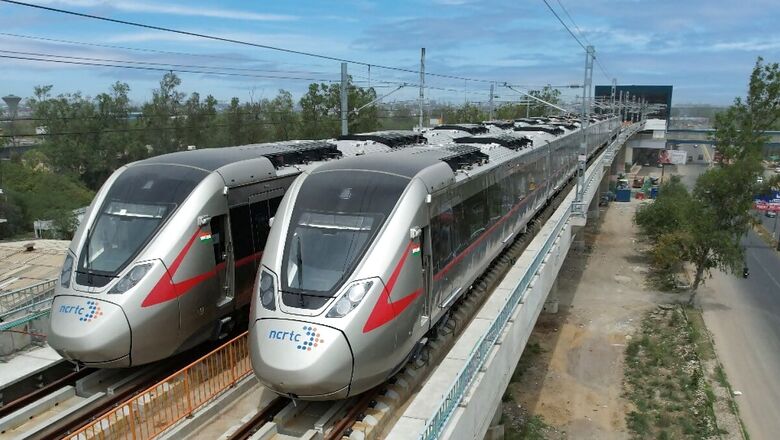
views
India’s first Regional Rapid Transit System (RRTS) train, which will be flagged off by Prime Minister Narendra Modi between Sahibabad and Duhai Depot on Friday, will be known as “Namo Bharat”.
PM Modi will flag off the 17-km priority section of the Delhi-Ghaziabad-Meerut RRTS corridor between Sahibabad and Duhai Depot on Friday.
With the train service operational, the travel time between Sahibabad and Duhai Depot will be 12 minutes, which would usually take around 30-35 minutes by road.
Reacting to the news, Congress General Secretary in-charge Communications Jairam Ramesh said there is simply no limit to his self-obsession.
“After Namo stadium now Namo trains. There is simply no limit to his self-obsession,” Ramesh said.
After Namo stadium now Namo trains. There is simply no limit to his self-obsession. https://t.co/tEt6zU8h5e— Jairam Ramesh (@Jairam_Ramesh) October 19, 2023
Congress leader Pawan Khera said just change the name of the country to “Namo”.
Why even put Bharat?Just change the name of the country to Namo and be done with it. https://t.co/vcRaK4tJXM— Pawan Khera (@Pawankhera) October 19, 2023
WHAT IS RRTS?
A new, dedicated, high-speed, high-capacity, commuter service, the Regional Rapid Transit System (RRTS) is different from both conventional railways as well as Metros.
It is better than conventional railways as it provides reliable, high-frequency, point-to-point regional travel.
It is different from Metros as it caters to passengers who are looking to travel a comparatively longer distance with fewer stops and at a higher speed.
HOW WILL IT CHANGE TRAVEL EXPERIENCE?
Offering comfortable seats and air conditioning, the priority section of RRTS is going to uplift travel in Ghaziabad.
Otherwise, the options so far for the commuters were public autorickshaws and buses, or private buses or taxis, amid the hot and humid weather clubbed with traffic.
The RRTS trains were designed for 180 kmph and have been tested for an operating speed of 160 kmph. However, its average speed is going to be 100 kmph. In June, the Railway Board approved that RRTS can operate at a maximum speed of 160 kmph on the priority corridor.
The 17-kilometre distance between the two stoppages takes around 30-35 minutes by road, which can be covered in just 12 minutes with RRTS, an official told News18.
There are five stations in the 17-km priority section — Sahibabad, Ghaziabad, Guldhar, Duhai, and Duhai Depot.
Built at a height of 26 metres, Ghaziabad station will be the highest among the stations on the Delhi-Meerut corridor.
The new service will also ease the journey for those who travel every day to and from Delhi.
The Ghaziabad station is seamlessly integrated with the Shaheed Sthal Metro station, on the Red Line of Delhi Metro, to enable commuters to comfortably move from one mode to another. A similar arrangement is being done across the entire stretch wherever there is a nearby Metro.
The Sahibabad RRTS station is just 4 km away from the Vaishali Metro Station situated on the Blue line of the Delhi Metro.
Once fully operational, there will be a station of RRTS in Vaishali that will be connected with the Vaishali Metro Station.
While designing the plan, the NCRTC ensured that the commuters get all the comfort they need, also making it accessible for all – with large lifts and designated space for wheelchairs and stretchers inside the train.
Further, to ensure a reliable mobile network for the commuters of the train, NCRTC last month invited tenders for mobile coverage solution providers. This will ensure that the commuters get a mobile network within the tunnels that connect underground stations on the RRTS corridor.
Also, once the entire stretch is functional, the RRTS will give the comfort of a Metro train, with service distance of conventional Railways.
The 82-km Delhi-Meerut section is likely to be completed by 2025 at a cost of Rs 30,000 crore.




















Comments
0 comment